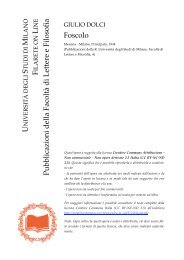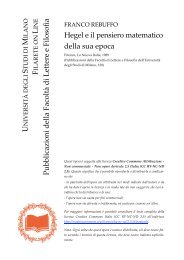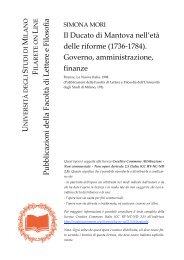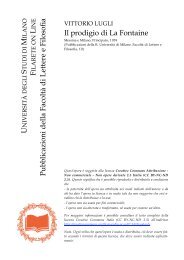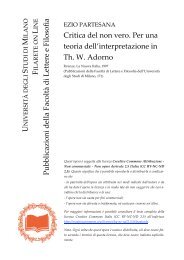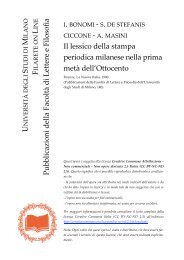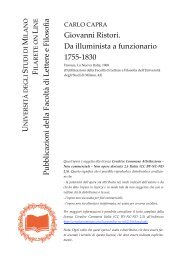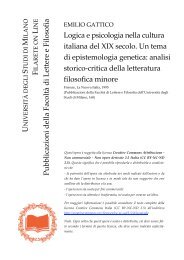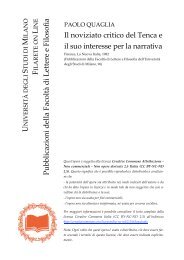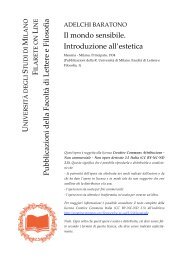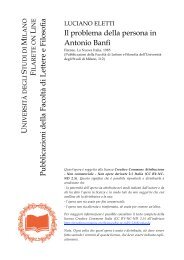U S M F L P u bblicazion i della Facoltà di Lettere e Filosofia La ...
U S M F L P u bblicazion i della Facoltà di Lettere e Filosofia La ...
U S M F L P u bblicazion i della Facoltà di Lettere e Filosofia La ...
Create successful ePaper yourself
Turn your PDF publications into a flip-book with our unique Google optimized e-Paper software.
LE TEORIE CLASSICHE DEGLI STILI 45<br />
tanquam ornata in se habeat exilitatem quandam & elegantiam, gravis vero molem<br />
& magnitu<strong>di</strong>nem. Ri<strong>di</strong>cala autem haec ratio est 53 .<br />
Se ne deduce intanto, a <strong>di</strong>spetto dell'or<strong>di</strong>ne successivo <strong>di</strong> trattazione,<br />
che una più esatta <strong>di</strong>slocazione degli stili « simplices » (haplòt), la quale<br />
tenga conto delle possibilità <strong>di</strong> commistione, se non dell'opinione qui<br />
confutata dallo pseudo-Demetrio <strong>della</strong> sostanziale bi o tripartizione <strong>di</strong><br />
«ssi, può essere la seguente: 1. tennis, 2. ornata, 3. gravis, 4. ma<br />
gnifica. Le « notae » estreme, « e regione positae », non sono mescola<br />
bili fra loro, mentre ogni altra commistione è possibile. Gli stili — ag<br />
giungiamo — sono dunque molteplici in concreto, ma la teorizzazione e<br />
la precettistica possono tenere o <strong>di</strong> fatto tengono conto solo delle forme<br />
semplici, limitandosi ad in<strong>di</strong>care genericamente l'esistenza delle forme<br />
composite M .<br />
Ma la presa <strong>di</strong> posizione polemica del retore greco è intesa sostan<br />
zialmente a riven<strong>di</strong>care l'autonomia dei suoi « charactères ». Lo pseudo-<br />
Demetrio è costante nel definire e piuttosto rigoroso nel <strong>di</strong>videre i quat<br />
tro stili « haplòi »: non manca <strong>di</strong> sottolinearne le occasionali somiglian-<br />
ze quando c'è convergenza nei concetti o nell'uso delle figure e degli<br />
altri artifici retorici o grammaticali, così come sovente in<strong>di</strong>vidua e sot<br />
tolinea con affermazioni esplicite gli elementi <strong>di</strong> opposizione o <strong>di</strong>ver-<br />
53 Vettori 1562, p. 36. Da notare che charactèr viene tradotto con « nota »,<br />
<strong>di</strong> cui nel commentario vien data l'origine (« notas, quae in lateribus armentorum<br />
candente ferro inuruntur ») e giustificato l'uso: « Translato igitur inde verbo, cha<br />
ractères vocatae sunt etiam, quibus genera <strong>di</strong>cen<strong>di</strong> <strong>di</strong>stinguuntur, notae ac for-<br />
mae etc. ».<br />
54 Cfr. ancora Morpurgo Tagliabue 1980, p. 75: presentati gli stili semplici,<br />
osserva: « poi ci sono le loro combinazioni, che però non fanno sistema: Deme-<br />
trio le coglierà <strong>di</strong> continuo, e con acume, ma sempre in modo <strong>di</strong>sinvolto e occa<br />
sionale ». <strong>La</strong> Schenkeveld (1964, pp. 53-56) ritiene che il concetto <strong>di</strong> commistione<br />
<strong>di</strong> stili non in<strong>di</strong>chi, come viceversa negli altri retori antichi, l'alternanza <strong>di</strong> forme<br />
pure in passi contigui, ma « fusione » <strong>di</strong> esse in un medesimo passo: « As Deme-<br />
trius has said, thè four charactères may be mixed, with exception of thè grand<br />
and thè plain style. What does Demetrius mean by thè word ' mixture '? We are<br />
inclined to refer here to thè mixture of styles as given by Dionysius, who consi-<br />
ders Piato's <strong>di</strong>ction to be mixed, because thè latter uses at one time thè plain<br />
<strong>di</strong>ction, at another time thè elevated one. In comparison with this, Demetrius'<br />
conception of mixture seems to be more restricted, for there appear to be some<br />
^hort passages, which belong to two or more types of style at thè same time »<br />
(p. 55). E dopo alcuni esempi conclude: « We may conclude therefore that to<br />
Demetrius mixture of styles means that even viewed from thè same aspect, a<br />
-passage may belong simultaneously to several types of style » (pp. 55-56).



